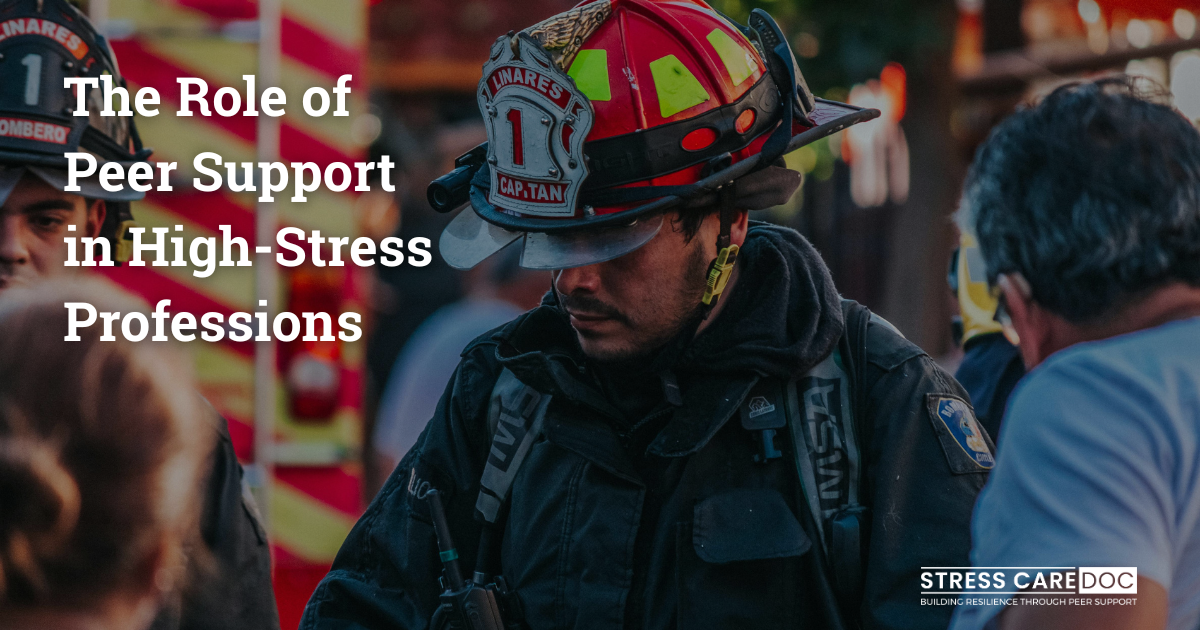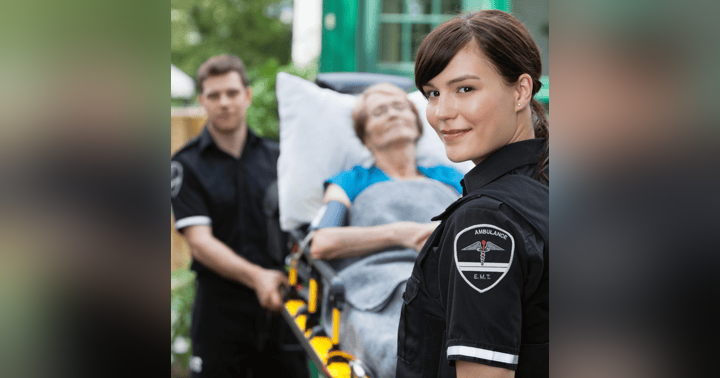The Role of Peer Support in High-Stress Professions

The role of peer support in firehouses, police departments, ERs, and dispatch centers is more important than ever. Professionals in these high-stress environments carry a silent load. Long hours, life and death decisions, traumatic events, and the pressure to perform can add up fast. What most people outside the job don’t realize is that the biggest battles aren’t always the ones in the field—they’re the ones inside.
That’s why peer support matters.
When someone on the team struggles with burnout, moral injury, family stress, or personal trauma, they don’t always want to talk to a supervisor or a counselor. But they might open up to someone who “gets it”—a peer who’s walked in their shoes and faced similar battles. Peer support creates a space for that kind of honest connection, and it can make the difference between a person breaking down or getting back up.
Whether you’re new to the concept or trying to build a more effective program in your department, understanding what peer support really is—and isn’t—can help save careers, marriages, and even lives.
What is Peer Support?
Peer support is a structured way for trained peers—people from within the same job or organization—to offer emotional, psychological, and practical support to others who are struggling. It’s built on trust, shared experience, and a non-judgmental approach.
What makes peer support powerful is that it’s based on mutual understanding. A paramedic who has worked back-to-back shifts and seen back-to-back losses will often feel more comfortable talking with another medic than a therapist who’s never worked a scene. The same goes for officers, ER nurses, dispatchers, and firefighters. The shared language, culture, and stressors build trust that’s hard to find anywhere else.
A well-trained peer supporter knows how to listen, how to recognize when someone needs more help, and how to point them toward the right resources. But they’re not there to fix. They’re there to stand alongside someone and say, “You’re not alone in this.”
What Peer Support Isn’t: Dispelling Common Misconceptions
There are a lot of misconceptions floating around about peer support. Some folks think it’s just a place to vent. Others worry it’s counseling in disguise or that it’ll be used against them later. Let’s clear that up.
First, peer support is not therapy. Peer supporters aren’t trying to diagnose or treat mental health conditions. They’re not replacing licensed professionals or offering clinical advice. Instead, they’re a safe, confidential first stop for someone who needs to talk, decompress, or make sense of what they’re going through.
Second, peer support isn’t gossip or rumor-sharing. A good program trains its members in confidentiality, boundaries, and ethics. What’s shared in a peer conversation stays there—unless someone is at risk of harm, which follows the same rules as any ethical or legal mandate.
And third, peer support isn’t only for after a major crisis or trauma. Yes, it plays a vital role in those moments. But more often, it’s about everyday stress—relationship struggles, parenting stress, job frustration, lack of sleep, burnout, and moral fatigue. That’s where the magic in peer support happens: in the ordinary struggles that build over time and can take a person out if no one’s paying attention.
The Difference Between Crisis Intervention and Comprehensive Peer Support
Crisis intervention peer support, and what I call comprehensive peer support are similar, but not quite the same.
Crisis intervention—especially the kind taught in CISM (Critical Incident Stress Management)—is designed to respond to high-impact, short-term events. Think line-of-duty deaths, fatal accidents, child deaths, or traumatic calls. These situations often call for a team response, possibly a defusing or debriefing, and often involve a trained mental health professional working alongside peers. The goal is to stabilize and support people in the immediate aftermath of a traumatic event.
Comprehensive peer support goes beyond that. It covers the everyday stuff—the slow burn of cumulative stress that builds shift after shift. It includes peer check-ins, ongoing conversations, one-on-one support, mental health education, and even helping someone navigate a tough season at home. It also plays a critical role in connecting people to resources before things get to a crisis point.
The most effective departments have both: a trained crisis response team and a broader peer support network that covers the day-to-day.
Benefits of Peer Support in High-Stress Environments
So why does peer support matter so much in high-stress workplaces?
For starters, it reduces stigma. When someone sees their coworker open up about therapy or getting help, it sends a powerful message: you don’t have to suffer in silence. That kind of culture change can ripple across a department.
It also increases retention. Studies have shown that people are more likely to stay in their job when they feel supported—not just professionally but personally. Peer support helps build that sense of connection and care.
Peer support can also lead to earlier intervention. Instead of waiting until someone is suicidal, drinking heavily, or completely burned out, a peer supporter might notice changes and start a conversation early. That early nudge can make all the difference.
And don’t overlook the benefit to the peer supporters themselves. Being trained to support others often deepens their own awareness and resilience. It fosters empathy, builds leadership, and strengthens the team.
Practical Steps to Building or Improving a Peer Support Program
If your department doesn’t have a peer support team yet, or if you want to improve the one you have, here are some steps to get started:
- Get Leadership Buy-In. No program will last without support from the top. Leaders need to understand the value of peer support and be willing to protect the time and resources needed for it to grow.
- Choose the Right People. Not everyone is cut out for peer support. Look for people who are trusted, good listeners, emotionally mature, and respected by their peers—not just the most senior or vocal.
- Provide Quality Training. Peer supporters should be trained in active listening, confidentiality, mental health basics, and referral protocols. Look for programs like those offered by The Stress Care Doc that are specifically designed for first responders and frontline professionals.
- Set Clear Policies and Procedures. Outline the purpose of the program, how it works, what the limits of confidentiality are, and how supporters are selected and trained. This builds trust and consistency.
- Build Awareness. Use roll calls, posters, newsletters, or internal platforms to make sure people know the team exists and how to reach them.
- Offer Ongoing Support and Supervision. Peer supporters need space to process what they hear and manage their own stress. Regular check-ins, refresher training, and support from mental health professionals are essential.
Available Resources and Training Programs through The Stress Care Doc
If you’re serious about starting or growing a peer support team, you don’t have to do it alone. At The Stress Care Doc, you’ll find resources, training, and personalized help for first responder agencies, hospitals, and high-stress organizations.
Some of the most helpful resources include:
-
Crisis Intervention and Peer Support Training – Learn how to build a team trained in both everyday support and critical incident response.
-
Suicide Intervention Train-the-Trainer Programs – Multiply your impact by equipping leaders in your organization to train others.
-
Comprehensive Peer Support Planning – Step-by-step guidance to design a sustainable, effective program tailored to your team.
-
Workshops and Speaking Engagements – Bring expert-led training to your next leadership meeting, conference, or in-service training day.
You can schedule a consultation or download free tools to help you get started. Just head to stresscaredoc.com and click on “Training” or “Resources.”
The Life-Saving Impact of Effective Peer Support
The truth is, high-stress jobs will always come with high stakes. But no one should have to carry those burdens alone.
Peer support isn’t about being a therapist or having all the answers. It’s about being present, being trained, and being trustworthy. It’s about building a culture where saying, “I’m not OK” is met with, “Let’s talk.”
Whether you’re leading a department, serving on the front lines, or just starting to think about wellness in your workplace, peer support is one of the most powerful tools you can use to protect your people.
Because when we show up for each other, we don’t just survive the job—we finish it strong.






